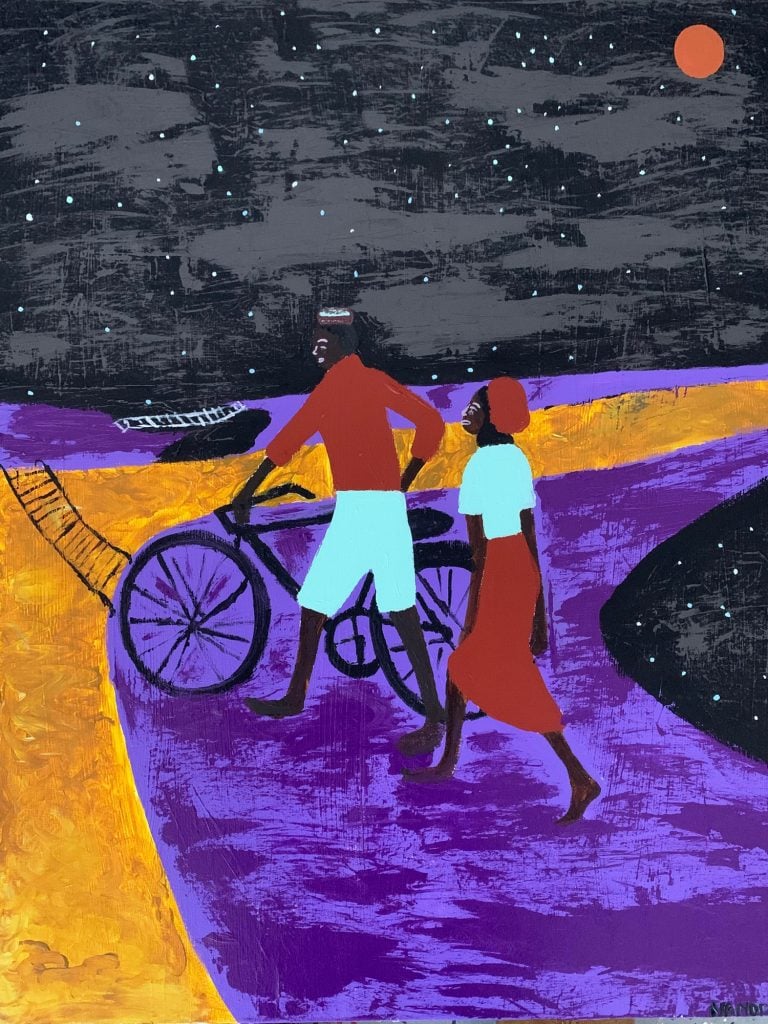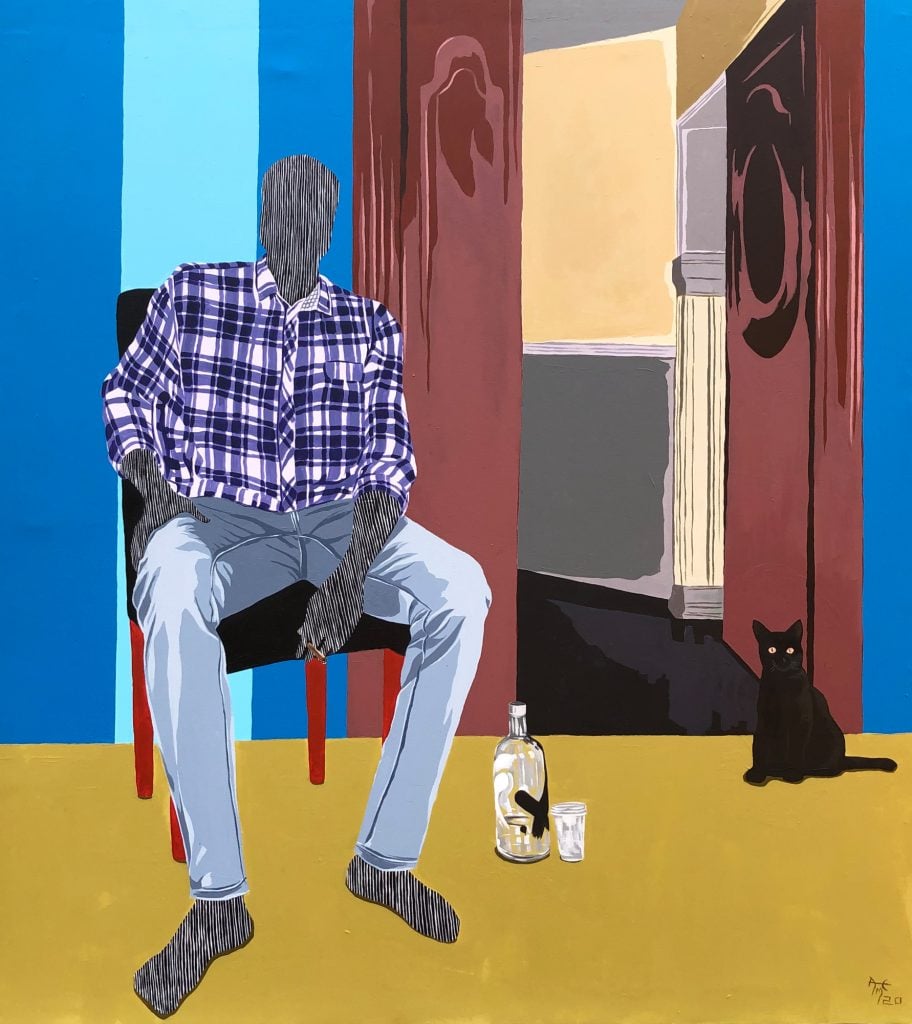Market
A New Hybrid Auction-Fair Event Wants to De-Center the Established Art Capitals by Focusing on the Global South. Can It Work?
We asked some of the participants in South South Veza to share their experiences.

We asked some of the participants in South South Veza to share their experiences.

Naomi Rea

The pandemic has disrupted art businesses everywhere, but the reduced ability to travel and the absence of international exhibitions and fairs has exacerbated the isolation of galleries and artists working outside of the established art capitals.
Enter South South Veza, a novel sales platform that centers the Global South. Part auction, part online fair, the new model hopes to bring momentum to corners of the market that have been neglected during the pandemic. The platform debuted on February 23 with a live, 22-lot auction and a 49-lot timed online auction, which kicked off a week of online viewing rooms.
The hybrid format is being introduced amid a wider blurring of the boundaries between the traditional territories of galleries and auction houses, as private sales become more important for the main houses, and the demand for ultra-contemporary work continues to soar.
Liza Essers, owner of South Africa’s Goodman Gallery and the platform’s founder, explains that the idea for the live selling event was to create an auction that would serve galleries, artists, and collectors “rather than auction houses.”
Inviting primary market galleries to an auction is exciting for a number of reasons. Prices at auction respond to demand and competition can help generate a healthy profit that—unlike on the secondary market—can actually benefit the artist and the gallery. Meanwhile, a hybrid event has the potential to attract clients interested in both the auction and the fair formats, broadening the network of potential buyers. Notably, the platform shares the identities of buyers and underbidders with the galleries, valuable relationship-building data that is usually closely guarded by auction houses.
But the approach can be a risky one, too. The public nature of an auction means that if something fails to sell, the work may be seen as tarnished and could negatively impact the artist’s market.
“Indeed, auctions can make or break an artist,” Daudi Karungi, artist and founder of the Kampala-based Afriart Gallery, which took part in the live auction, says. “However, with us, we went into the auction with the primary goal of raising funds for the not-for-profit organizations South South is supporting.”
For sales made during the live auction, up to 20 percent of the hammer price was split among three art centers in the Global South, RAW Material Company in Dakar; Green Papaya Art Projects in Manila; and Casa do Povo in São Paulo. The charity element of the event was a draw for many of the participating galleries, which stressed the importance of these nonprofits in supporting the wider arts ecosystem.
The 22-lot live auction attracted buying over the phone as well as online, with 250 bidders registered from all over the world. Galleries, and sometimes artists, presented their own work, and the sale totaled $464,000, with a 50 percent sell-through rate. (There were no buyers premiums for the lots, but 10 percent of the hammer price went to cover the operating costs of the event).
The highlight of the sale was a work by the Tanzanian artist Sungi Mlengeya offered by Afriart Gallery. Eleven bidders competed to drive the price up to $50,000, five times its lower estimate.
“We were sure the price would be above the high estimate because of the long waiting list for Sungi’s paintings,” Afriart’s founder Karungi says, adding that they were “gladly surprised” by the positive result, which confirmed the “overwhelming international demand” for the artist.
The live auction was followed by a 49-lot online sale of more emerging galleries, which saw a more muted 22.4 percent sell-through rate, with works selling for up to $15,000. (There was no charity element to this sale, although 10 percent of hammer went toward the platform cost).
Despite some energetic moments of bidding, both of the auction-style events had a comparatively low sell-through rate. The performance was not exactly unexpected for a brand new platform, and the organizers stressed that these sales should be regarded as akin to an art fair vernissage—a moment to give visibility to the works and inject a sense of urgency and dynamism to the week-long online viewing room that followed. (They also noted that they did not publicly release auction data in order to protect the artists.)

Ameh Egwuh, With A Smoke in My Hand (from the How Do You Love Yourself Series) (2020). Courtesy of South South Veza.
Despite the organizers’ sensitivity to gallery concerns, not all galleries participating in the platform opted to take part in the public sales. “There wasn’t necessarily a pushback based on the auction, but we didn’t want to put an emerging artist on an auction, period,” KJ Freeman, owner of New York’s HOUSING gallery says.
Freeman showed a solo presentation of work by the Mexican multimedia artist Sofia Moreno in the OVR portion of the event, and while there was an inquiry about the work during the fair, it was from an existing client who did not get in touch through the Veza platform.
“I think people are tired of OVRs,” Freeman says. The upside of the experience was lending support for Moreno’s practice, and the platform’s intention of uplifting voices in the Global South. “I think it’s a good idea but it would probably be more successful if it was in person,” she says, adding that physical events give more opportunity to make new discoveries by chance.
Others have had better luck with the OVR. Following the attention generated by the live sale, Afriart Gallery reported a positive experience, with new collectors interested in paintings by Henry Mzili Mujunga and Richard Atugonza’s sculptures.
The more established Kurimanzutto gallery, which had offered a work by Gabriel Orozco that did not find a buyer during the vernissage, was able to place four works in regional collections during the OVR, and saw sustained interest in ceramic works by the Mexican artist Dr. Lakra.
“We have witnessed a lot of attention and traction from this side of the world and we believe this will grow into something very important for the southern hemisphere,” the gallery’s founder and director, José Kuri, says.
Rakeb Sile, director of Addis Fine Art, reported interest from new collectors and a couple of institutions in work by Ermias Kifleyesus and Tesfaye Urgessa through the OVR. But she stressed that it was the year-round programming and connections with other galleries that most interested her about the initiative.
Indeed, the market event is part of the wider ambition of South South. The sales platform launched concurrently with a year-round resource hub, which will promote participating gallery programs as well as provide an archive of art-historical research and profiles of artists from the Global South. Its programming includes talks and events exploring alternative art centers, and addressing topical issues including decolonization, restitution, and the movement for racial justice.
Mary Sabbatino, director of Galerie Lelong & Co., and one of the South South collaborators, summarized it neatly: “The objective is to build a community of artists, gallerists, curators, and patrons who have all had a deep interest in both the decentralization of art production and the richness and depth of artistic expression in the Global South.”